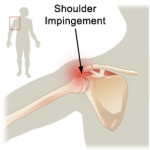Michael Baugh CDBC CPDT-KSA
They call it an impingement, and as rotator cuff injuries go it’s not one of the bad ones. That information by itself inspires the deepest respect for my fellow middle aged weekend warriors who have serious shoulder injuries. I moved my arm the wrong way once and it  literally floored me, took my breath away. I thought I was going to throw up. What kind of pain must the others be shouldering, the dislocations and the tears?
literally floored me, took my breath away. I thought I was going to throw up. What kind of pain must the others be shouldering, the dislocations and the tears?
“Doctor, it really hurts when I do this.” I fully expected him to say, “Well, don’t do that anymore.” He actually didn’t say that. It’s an old joke that, when you think about it, is a bit condescending and wholly unsatisfying. And yet, it’s exactly what I’ve told countless clients who are struggling with dog behavior issues. My dog goes crazy when I take him on walks. (Don’t do that anymore). My dog bites me when I pet him (Don’t do that). He growls when I reach for his toy (Don’t). When my daughter’s friends run through the house… (Stop, please).
We trainers know the logic behind this. It’s called antecedent control. If we can shut down what’s triggering the dog, the behavior stops. We get a break. It really is part of the solution. I had stopped doing what really hurt the most long before I went to the doctor – reaching, reaching up and to the side, or bending low and reaching far like the time I tried to get my dog’s ball from under the sofa. That kind of pain makes it hard to get back up. Don’t do that anymore, right?
If you’ve never been, physical therapy is like going to a gym where everyone gets a personal trainer, an assistant personal trainer, and an intern. Insurance pays for it and the weights are pretty light. I liked it right away. It also helped me better understand dog training. Avoiding the shoulder pain was a good idea – just like sequestering a violent dog is a smart move. But it’s a bit unsatisfying. What’s the rest of the solution? The answer kind of surprised me – and I was surprised that it surprised me because of how closely in parallels dog training.
 Many (okay most) of my clients think we are taking their hair-trigger cute-faced biter out into the world on our first visit to “see what happens.” As a trainer, I know that makes no sense. So, why did I think physical therapy for my shoulder was going to involve my shoulder directly – triggering the pain, stretching my arm behind my back, reaching for the peanut butter jar? What silly patient I was.
Many (okay most) of my clients think we are taking their hair-trigger cute-faced biter out into the world on our first visit to “see what happens.” As a trainer, I know that makes no sense. So, why did I think physical therapy for my shoulder was going to involve my shoulder directly – triggering the pain, stretching my arm behind my back, reaching for the peanut butter jar? What silly patient I was.
I’m not a doctor or a physical therapist, but here’s my understanding. Healing an injured joint is all about building the supporting muscles around the joint. Its also about relaxing the joint and creating room for easier motion. And all this involves teaching the body new behaviors, how to fire oft ignored muscles, how to sit and stand with better posture. For my shoulder it was all about working on my back. Go figure.
Sure, this was just a bit confusing at first, but so enlightening too. How odd it must seem to dog training clients when we begin teaching their angry dog obedience cues, impulse control exercises, and relaxation protocols. We know, but do we fully explain, that we’re teaching the dog behaviors that will support them when they feel the most stress or fear?We’re helping them self-regulate and relax so they can make better behavior choices when it matters most. Sometimes it doesn’t look at all like teaching the dog stop lunging, or biting, or growling. It’s about teaching new behavior and loosening the dog up around the problem area. Go figure.
Physical therapy, like dog training, can be challenging. There are regular visits and homework. Lots of homework. All these exercises for my back, teaching my scapula to move correctly, my chest to open up, my spine to curve correctly. In therapy and in dog training both, we break it down into individual tasks and build little by little. The dog attends to his owner more closely, targets the mat and her hand, follows better on leash, sits and lies down and stays. The routine gets boring at times – every day – more practice.
It’s hard sometimes to make the connection between the work and the goal. Maybe you notice, maybe you don’t, one day when your dog stays calm when another dog passes, walks away when you reach for his toy, snores peacefully when your kids’ friends run through the house. Maybe all you think about is that first warm cup when you reach for the coffee grinder, high up on the second shelf. You take your first sip before you realize – it didn’t hurt.


